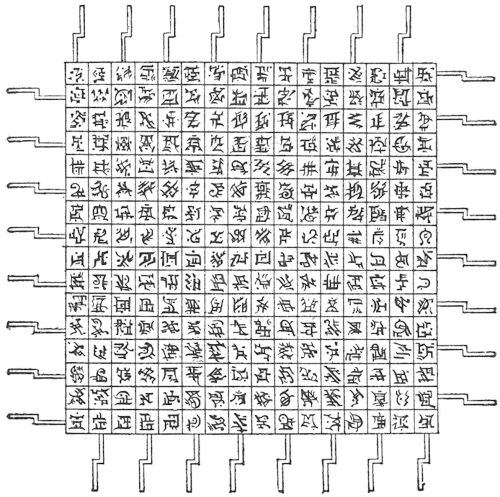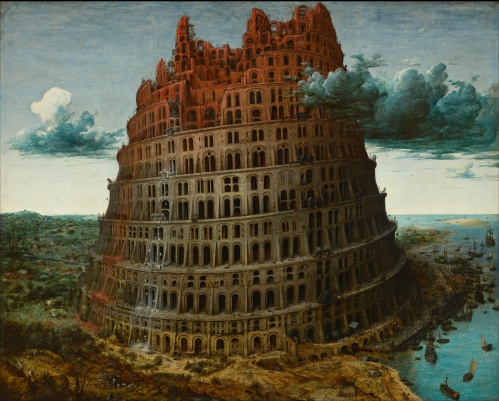Eco: The Alphabet and the Four Figures, 3

Jonathan Swift, Gulliver’s Travels, 1892 George Bell and Sons edition, Project Gutenberg. Also see Jonathan Swift, Gulliver’s Travels, A.J. Rivero, ed., New York: W.W.Norton, 2001, Part III, chapter 5. Cited in Bethany Nowviskie, “Ludic Algorithms,” in Kevin Kee, ed., Pastplay: Teaching and Learning History with Technology, Ann Arbor, MI: University of Michigan Press, 2014.
“It follows that Lull’s art is not only limited by formal requirements (since it can generate a discovery only if one finds a middle term for the syllogism); it is even more severely limited because the inferences are regulated not by formal rules but rather by the ontological possibility that something can be truly predicated of something else.
The formal rules of the syllogism would allow such arguments as “Greed is different from goodness — God is greedy — Therefore God is different from goodness.” Yet Lull would discard both the premises and the conclusion as false.
The art equally allows the formulation of the premise “Every law is enduring,” but Lull rejects this as well because “when an injury strikes a subject, justice and law are corrupted” (Ars brevis, quae est de inventione mediorum iuris, 4.3a).
Given a proposition, Lull accepts or rejects its logical conversion, without regard to its formal correctness (cf. Johnston 1987: 229).
Nor is this all. The quadruples derived from the fourth figure appear in the columns more than once. In Ars magna the quadruple BCTB, for example, figures seven times in each of the first seven columns.
In V, 1, it is interpreted as “Whether there exists some goodness so great that it is different,” while in XI, 1, applying the rule of logical obversion, it is read as “Whether goodness can be great without being different”–obviously eliciting a positive response in the first case and a negative one in the second.
Yet these reappearances of the same argumentative scheme, to be endowed with different semantic contents, do not bother Lull. On the contrary, he assumes that the same question can be solved either by any of the quadruples from a particular column that generates it, or from any of the other columns!
Such a feature, which Lull takes as one of the virtues of his art, represents in fact its second severe limitation. The 1,680 quadruples do not generate fresh questions, nor do they furnish new proofs.
They generate instead standard answers to an already established set of questions. In principle, the art only furnishes 1,680 different ways of answering a single question whose answer is already known.
It cannot, in consequence, really be considered a logical instrument at all. It is, in reality, a sort of dialectical thesaurus, a mnemonic aid for finding out an array of standard arguments able to demonstrate an already known truth.
As a consequence, any of the 1,680 quadruples, if judiciously interpreted, can yield up the correct answer to the question for which it is adapted.
See, for instance, the question “Whether the world is eternal” (“Utrum mundus sit aeternus“). Lull already knew the answer: negative, because anyone who thought the world eternal would fall into the Averroist error.
Note, however, that the question cannot be generated directly by the art itself; for there is no letter corresponding to world. The question is thus external to the art.
In the art, however, there does appear a term for eternity, that is, D; this provides a starting point.
In the second figure, D is tied to the relative principle contrarietas or opposition, as manifested in the opposition of the sensible to the sensible, of the intellectual to the sensible, and of the intellectual to the intellectual.
The same second figure also shows that D forms a triangle with B and C. The question also began with utrum, which appears at B under the heading Questiones in the tabula generalis. This constitutes a hint that the solution needs to be sought in the column in which appear B, C and D.
Lull says that “the solution to such a question must be found in the first column of the table;” however, he immediately adds that, naturally, “it could be found in other columns as well, as they are all bound to each other.”
At this point, everything depends on definitions, rules, and a certain rhetorical legerdemain in interpreting the letters. Working from the chamber BCDT (and assuming as a premise that goodness is so great as to be eternal), Lull deduces that if the world were eternal, it would also be eternally good, and, consequently, there would be no evil.
“But,” he remarks, “evil does exist in the world as we know by experience. Consequently we must conclude that the world is not eternal.” This negative conclusion, however, is not derived from the logical form of the quadruple (which has, in effect, no real logical form at all), but is merely based on an observation drawn from experience.
The art may have been conceived as the instrument to use universal reason to show the Averroist Muslims the error of their ways; but it is clear that unless they already shared with Lull the “rational” conviction that the world cannot be eternal, they are not going to be persuaded by the art.”
Umberto Eco, The Search for the Perfect Language, translated by James Fentress, Blackwell. Oxford, 1995, pp. 62-4.

